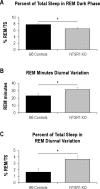Altered sleep and affect in the neurotensin receptor 1 knockout mouse
- PMID: 22754041
- PMCID: PMC3369230
- DOI: 10.5665/sleep.1958
Altered sleep and affect in the neurotensin receptor 1 knockout mouse
Abstract
Study objective: Sleep and mood disorders have long been understood to have strong genetic components, and there is considerable comorbidity of sleep abnormalities and mood disorders, suggesting the involvement of common genetic pathways. Here, we examine a candidate gene implicated in the regulation of both sleep and affective behavior using a knockout mouse model.
Design: Previously, we identified a quantitative trait locus (QTL) for REM sleep amount, REM sleep bout number, and wake amount in a genetically segregating population of mice. Here, we show that traits mapping to this QTL correlated with an expression QTL for neurotensin receptor 1 (Ntsr1), a receptor for neurotensin, a ligand known to be involved in several psychiatric disorders. We examined sleep as well as behaviors indicative of anxiety and depression in the NTSR1 knockout mouse.
Measurements and results: NTSR1 knockouts had a lower percentage of sleep time spent in REM sleep in the dark phase and a larger diurnal variation in REM sleep duration than wild types under baseline conditions. Following sleep deprivation, NTSR1 knockouts exhibited more wake and less NREM rebound sleep. NTSR1 knockouts also showed increased anxious and despair behaviors.
Conclusions: Here we illustrate a link between expression of the Ntsr1 gene and sleep traits previously associated with a particular QTL. We also demonstrate a relationship between Ntsr1 and anxiety and despair behaviors. Given the considerable evidence that anxiety and depression are closely linked with abnormalities in sleep, the data presented here provide further evidence that neurotensin and Ntsr1 may be a component of a pathway involved in both sleep and mood disorders.
Keywords: NTSR1; Sleep; anxiety; depression; neurotensin.
Figures






References
-
- Andretic R, Franken P, Tafti M. Genetics of sleep. Annu Rev Genet. 2008;42:361–88. - PubMed
-
- O'Hara BF, Ding J, Bernat RL, Franken P. Genomic and proteomic approaches towards an understanding of sleep. CNS Neurol Disord Drug Targets. 2007;6:71–81. - PubMed
-
- Martin EI, Ressler KJ, Binder E, Nemeroff CB. The neurobiology of anxiety disorders: brain imaging, genetics, and psychoneuroendocrinology. Clin Lab Med. 2010;30:865–91. - PubMed
-
- Lamont EW, Coutu DL, Cermakian N, Boivin DB. Circadian rhythms and clock genes in psychotic disorders. Isr J Psychiatry Relat Sci. 2010;47:27–35. - PubMed
Publication types
MeSH terms
Substances
LinkOut - more resources
Full Text Sources
Molecular Biology Databases

